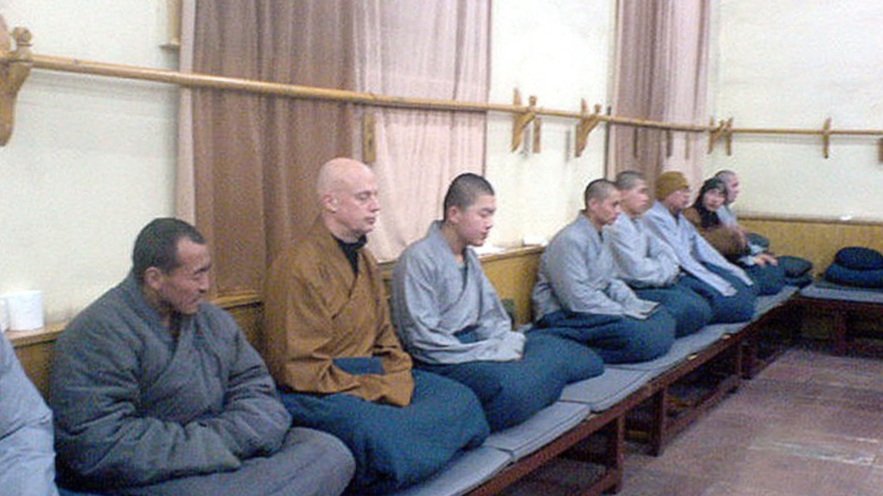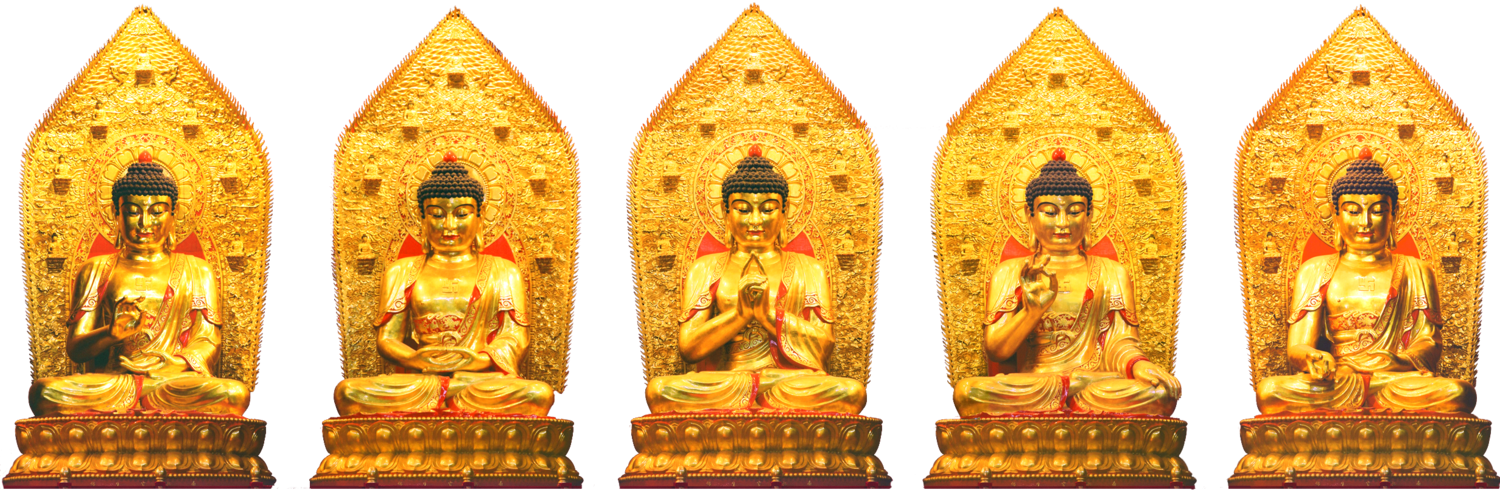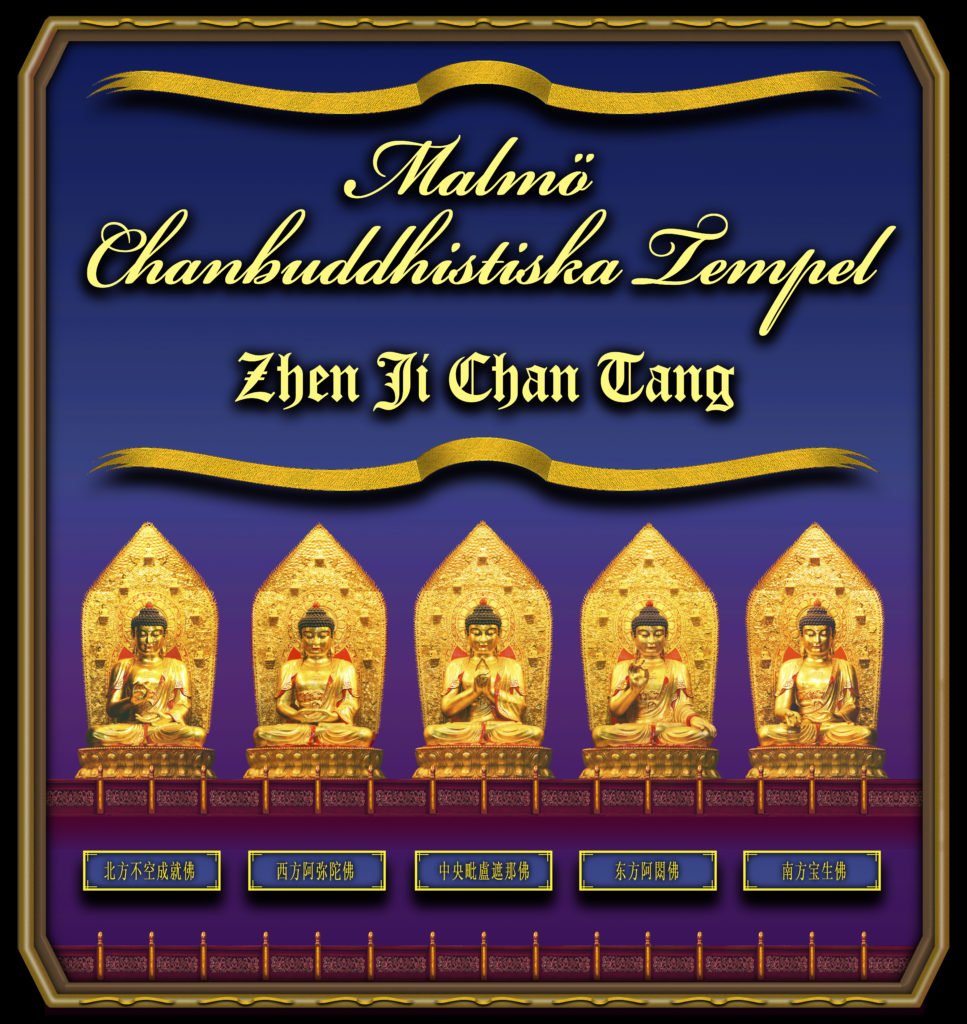
明寳 Dharma Master Míng-Bao
明寳 Míng-Bǎo (Treasure of Light )
Míng-Bǎo in 2005
Míng-Bǎo was born in 1949 to Danish immigrants as Johnny Petersen in Gislaved in the Småland district of Sweden. Due to some deep inner experiences in his youth, Míng-Bǎo turned to Buddhism to find explanations. He tells:
-In the Heart Sūtra we read that the real and one mind, neither has form nor color, scent nor taste, and so on, i.e. there is nothing to grab on to, no clinging possibilities. Here is a recollection of such an experience:
In 1975, two good friends and Dharma bums spend their summer in Denmark – the home of pastries and Hamlet – in the middle of an island called Fyn. They rented a former farm lodge with their families and by the time the women and children were going to bed these two fellows went out into the midsummer night. By midnight they settled down on a hill overlooking the near countryside. As Indian Sadhus (Shiva), they spread out their rugs, stuck the stick into the ground, lit some incense, and found themselves a power spot where they could merge with the earth.
After a couple of hours of deep meditation, breathing with the earth they slowly turned towards each other and happened to fix each other’s gaze. After some time, gazing into each other’s eyes, they both slowly began to realize that the other one is breaking through the outer shield of personality, the mask we carry in our daily life. “Hmm, far out!” they both thought, “but that sucker is not going to penetrate me any deeper than this.” ”Sucker?” the other one thinks. ”Shit, he can see what is going on in my mind,” the first one realizes. And on it goes, piece by piece, layer by layer, like peeling an onion. And repeatedly they each come to the point where they try to resist the opening of the secret doors in the inner part of their mind. And again, there is nothing whatsoever to do about it, other than turning away from the gaze – and that, of course, is out of the question.
The outer layers might be alright for someone to peep into, but after that, it becomes more delicate. We all carry on characteristics we don’t want anyone to admit but no less are painfully aware of. The experience that someone is revealing these sides merely by looking into you is not comfortable and one tries to resist as long as possible.
So on it goes until there is nothing whatsoever left to hide, nor nowhere to hide it, because you feel like the skull has dissolved bit by bit, looking like a painting by Salvador Dalí, until there is absolutely nothing left.
Then something unexpected happens: your whole being, your whole existence is lifting, leveling, and lighting up; you feel how that what you usually consider as your ‘self’ is merging with everything around you, how it becomes an integrated part of existence instead of something separate as it used to be. Now is the time when one realizes that the only thing existent is the collective, original and universal Mind, the Clear Light!
After a while, the sun is rising over the horizon and slowly the rural landscape is awakening to life. The friends look around themselves and discover they have been sitting in the middle of turnip-field, like other plants…. Ignorant of the miracle on the hill a rooster crows in a sleepy tone, a chain-dog answers, a door is slammed and on the winding road a milk-truck is moving on. The temperature is rising and newborn the friends, now closer than ever, are walking homeward to the lodge that is their temporary home and to humbly enjoy the breakfast that their caring women have prepared for their homecoming “brave Dharma-warriors.”"
After returning to his hometown of Malmö in Southern Sweden, still deeply affected by the experience, he begins his search for answers. But there is no Buddhism nor Shaivism to be found and nothing much else he tells. Someone told him that north of Copenhagen, there’s a Tibetan Temple so he goes there and joins Lama Ole Nydahl for a year. But the only interesting thing that happened there was the visit by the 16th Karmapa and his Black Hat-ceremony. Mindblowing. Still not satisfied he looks further and suddenly finds a small group of people, meeting up every second Monday in a tiny basement room in East Malmö. The group is headed by Upāsaka Tào Míng who was a disciple of Dharma Master Tào Wèi in Gothenburg. At the first possible occasion Johnny, now 26, asked to become his disciple. Accepted, he now had to travel back and forth to Gothenburg to receive teachings. These teachings consisted only in Theravāda as DM Tào Wèi had the strong opinion, that if one didn’t master these first hand then one would not be able to understand the more lofty teachings of the Mahāyāna. DM Tao Wèi had been a monk in China between 1930 – 1936. In 1975, he went to Hong Kong to reordinate in the Tiāntāi Tradition. After four years of intense study, Johnny was asked to take refuge in 1979 and he then received the Dharma name Tào Chúan and was appointed Dharma Heir of DM Tao Wèi. As Tào Chúan didn’t find any answers in the Theravāda teachings he began to read about the Japanese Zen tradition. (There were no information on Chinese Chán availablein Sweden at the time). Sadly enough, this fact raised anger in DM Tào Wèi, and shortly before his untimely death in cancer in 1983, he made it clear that he could not be the teacher of Tào Chúan any longer.
After trying out a worldly career for fifteen odd years, Tào Chúan returned to his Buddhist studies in 1996, this time returning to Zen. After a while, he found the Chinese/American Zen Buddhist Order of Hsu Yun (Xū-Yún) on the internet and became one of their early members. Disappointed with some of the ideas of that group (US gun laws), he looked further. In England, there lived an Austrian Nun who had been trained in a Japanese temple for twelve years. She, The Ven. Myokyo-Ni had been a good friend of DM Tào Wèi, so Tào Chúan was welcomed to her training center in Luton, GB. Still not satisfied Tào Chúan looked further.
Soon he found the Ven. Chán Master Míng Qí in Geneva and she invited him to come to “her” monastery in China, the Baílín Chán Sí. Exciting, Tào Chúan thought. On his way there he paid a visit to the monastery of the Sixth Patriarch, Huí Nèng. The encounter with his mummy was overwhelming. It was, Tào Chúan recalls, as if Huí Nèng actually was in the room. Tào Chúan had to come back three days in a row and it was the same reaction every time. He just fell down, prostrating to the floor with tears in his eyes. At last, he had found what he was looking for.
When he arrived at Bǎi Lín Chán Sí and meeting with Ven. Míng Qí, it felt like coming home. Nothing felt strange. After a few days, the pair got to see The Ven. Grand Master Jíng Huí. Upon meeting him, Tào Chúan immediately prostrated to the floor again, finally having met his true master. After being presented by Míng Qí, GM Jíng Huí and Tào Chúan looked at one another and caught each other’s gaze. Time stopped. The room disappeared. Yìn-kě occured. After a while – a second, an hour – who knows, they both nodded their heads and it was decided that Tào Chúan should ordain as Shāmí (Śrāmaṇera/Novice). The ceremony took place three days later. In the end, now dubbed Míng Bǎo, the Master acknowledged Míng Bǎo by presenting him the traditional horse tail fly whisk, the Fūzǐ 拂子, making him a Dharma Master.
Ven. Jǐng Huì presenting Míng Bǎo with the Fūzǐ
Míng Bǎo went back to Malmö and established a meditation group that later developed into Ruì Diǎn Nán Chán/Southern Chánbuddhism in Sweden run by The Buddhist Society Tao Zen, with an affiliation in Gothenburg.
After a while, Míng Bǎo realized it was undoable to live the life of a monk in Malmö with no Sangha and no one to support him. After seeing DM Jíng Huí, Míng Bǎo decided to leave the monastic Sangha and go on teaching as a layman, a Master Upasaka.
Since then, Míng Bǎo runs the temple with the help of his trusted Lay Sangha.
Linjì-lineage: From 1st Ancestor to the 66th.
达摩 Bodhidharma/Dá-Mó (? – ca 530)
大祖慧可 Dà-Zǔ Huì-Kě (? – ?)
鑑智僧璨 Jiàn-Zhì Sēng-Càn (? – 606)
道信 Dà-yī Dào-Xìn (? – 651)
弘忍 Da-Man Hóng-Rěn (601 – 674)
大鑒惠能 Dà-Jiàn Huì-Néng (638–713)
南嶽懐譲 Nán-Yuè Huái-Ràng (677–744)
馬祖道 Mǎ-Zŭ Dào-Yī (709–788)
百丈懷海 Bǎi-Zhàng Huái-Hái (720–814)
黄檗希运 Huáng-Bò Xī-Yùn (? – 850)
臨濟義玄 Lín-Jì Yì-Xuán (? – 866)
興化存獎 Xīng-Huá Cún-Jiǎng (830 – 888)
南院慧顒 Nán-Yuàn Huì-Yóng (? – 952)
瘋穴延沼 Fēng-Xué Yán-Zhǎo (896 – 973)
首山省念 Shǒu-Shān Shěng-Niàn (926 – 993)
汾陽善昭 Fén-Yáng Shàn-Zhāo (947 – 1024)
石霜楚園 Shí-Shuāng Chǔ-Yuán (986 – 1039)
楊岐方會 Yáng-Qí Fāng-Hùi (992 – 1049)
白雲守端 Bái-Yún Shǒu Duān (1025 – 1072)
五祖法演 Wǔ-Zǔ Fǎ-Yǎn (1024 – 1104)
圜俉克勤 Yuánwù Kèqín (1063 – 1135)
虎丘紹隆 Hǔ-Qiū Sháo-Lóng (1077 – 1136)
應俺曇華 Yīng-ǎn Tán-Húa (1103 – 1163)
密俺咸榤 Mì-ǎn Xián-Jié (1118 – 1186)
破俺祖先 Pò-ǎn Zǔ-Xiān (1136 – 1211)
無準師範 Wú-Zhǔn Shī-Fàn (1174 – 1249)
淨慈妙侖 Jìng-Cí Miào-Lún (1201 – 1261)
瑞巖文寶 Ruì-Yán Wén-Bǎo (? – 1335)
華頂先覩 Húa-Dǐng Xiān-Dǔ (1265 – 1334)
福林智度 Fú-Lín Zhì-Dù (1304 – 1370)
古拙昌俊 Gǔ-Zhuō Chāng-Jùn (? – ?)
無際明俉 Wú-Jì Míng-Wú (? – ?)
太岡橙 Tài-Gāng-Chéng (? – ?)
矣峰寧 Yǐ-Fēng-Níng (? – 1491)
天目寶芳進 Tiān-Mù Bǎo-Fāng-Jìn (? – ?)
野滃慧嘵 Yě-Wěng Huì-Xiāo (? – ?)
無趣如空 Wú-Qù Rú-Kōng (1491 – 1580)
無幻性沖 Wú-Huàn Xìng-Chōng (1540 – 1611)
興善慧廣 Xīng-Shàn Huì-Guǎng (1576 – 1620)
普明徳用 Pǔ-Míng Dé-Yóng (1587 – 1642)
高菴圓淸 Gāo-ān Yuán-Qīng (? – ?)
本智明戄 Běn-Zhì Ming-Jué (? – ?)
紫柏真可 Zǐ-Bó Zhēn-Kě (1543 – 1603)
端旭茹弘 Duān-Xù Rú-Hóng (? – ?)
純榤性奎 Chún-Jié Xìng-Kuí (? – ?)
慈雲海俊 Cí-Yún Hǎi-Jùn (? – ?)
質生寂文 Zhì-Shēng Jì-Wén (? – ?)
端員照華 Duān-Yuán Zhào-Huá (? – ?)
其岸普明 Qí-Án Pǔ-Míng (? – ?)
弢巧通聖 Tāo-Qiǎo Tōng-Shèng (? – ?)
俉修心空 Wú-Xiū Xīn-Kòng (? – ?)
宏化原俉 Hóng-Hùa Yuán-Wú (? – ?)
祥青廣廣 Xiáng-Qīng Guǎng (? – ?)
守道續先 Shǒu-Dào Xù-Xiān (? – ?)
正岳本超 Zhēng-Yué Běn-Chāo (? – ?)
永暢矍 Yǒng-Chàng Jué (? – ?)
方來昌遠 Fāng-Lái Chāng-Yuǎn (? – ?)
豁俉隆參 Huò-Wú Lóng-Cān (? – ?)
維超能燦 Wéi-Chāo Néng-Càn (? – ?)
奇量仁繁 Qí-Liàng Rén-Fán (? – ?)
妙連聖華 Miào-Lián Shèng-Huá (? – ?)
鼎峰果成 Dǐng-Fēng Guǒ-Féng (? – ?)
善慈常開 Shàn-Cí Cháng-Kāi (? – ?)
徳情演徹 Dé-Qíng Yǎn-Chè/虛雲 Xū-Yún (1840 – 1959)
净慧老和 Jìng-Huì Lǎo-Hé (1940 – 2013)
明寳崇俉 Míng-Bǎo Chóng-Wù (1949 – still) >



